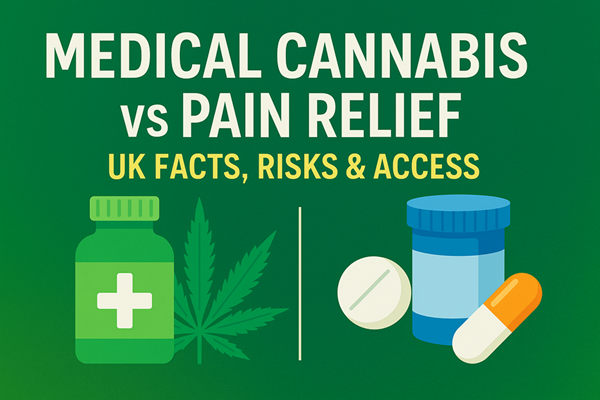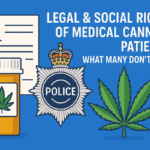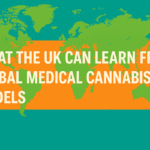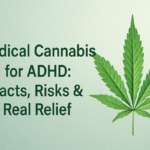Medical Cannabis vs. Other Pain Relief: What You Need to Know

Chronic pain is a complex beast. Many sufferers cycle through multiple treatments, often with limited success and unwanted side effects. Lately, medical cannabis is getting attention as an alternative or adjunct option. But how does it stack up against conventional pain relief? In the UK context, what’s legal, what works, and what risks do you face? Below we will walk you through:
- How medical cannabis works (and its legal status in the UK)
- Mainstream pain relief options (from simple to advanced)
- Pros, cons, and trade-offs
- Practical guidance and red flags
What is medical cannabis (or cannabis-based medicinal products, CBPMs)?
“Medical cannabis” is shorthand for cannabis-derived or cannabis-based medicinal products (CBPMs) that are used under medical supervision, not for recreational use.
In the UK:
- Since November 2018, cannabis for medicinal use has been legal in limited circumstances (i.e. as a prescription by specialist doctors).
- However, this does not mean it is freely available. Access is tightly controlled: only hospital specialists (or doctors on the specialist register) may initiate prescriptions.
- Where possible, licensed cannabis-derived medications (or formulations) are preferred over “unlicensed specials”.
- One such product is nabiximols (brand name Sativex), a THC/CBD oromucosal spray licensed in the UK for spasticity in multiple sclerosis.
NICE (the National Institute for Health & Care Excellence) has a guideline (NG144) on cannabis-based medicinal products, including their use in chronic pain, but is cautious in its recommendations. The British Pain Society similarly does not recommend CBPMs for routine chronic pain use due to limited evidence.
In short: medical cannabis is legally possible in the UK under narrow conditions, but it is not a “first line” option for most pain sufferers.
How does medical cannabis (cannabinoids) produce pain relief?
The active compounds in cannabis that draw interest are mainly THC (tetrahydrocannabinol) and CBD (cannabidiol). Here’s a simplified breakdown of mechanisms and theories:
- The human body has an endocannabinoid system (ECS), with cannabinoid receptors (CB1, CB2) that modulate pain signalling, inflammation, and other physiological responses.
- THC binds more directly to CB1/CB2 and has psychoactive effects; CBD influences the system more indirectly (e.g. modulating receptor activity, reducing inflammation).
- Some believe in an “entourage effect”, that the mix of compounds in whole-plant cannabis (minor cannabinoids, terpenes) produces more balanced effects than pure isolates.
- In pain, cannabinoids may reduce nerve excitability, reduce central sensitisation, modulate inflammatory mediators, or dampen pain signal transmission.
Clinical data is still emerging. Some studies report benefit, especially for neuropathic pain, but effect sizes and consistency are modest.
A 2024 review in BMJ Open comparing medical cannabis vs opioids for non-cancer chronic pain found mixed evidence: cannabis may offer modest relief with fewer risks of overdose but also carries its own side effects and uncertainties.
Conventional pain relief options: the landscape
Before considering medical cannabis, most patients will try a sequence of more standard analgesic approaches. Below is a hierarchy of options, roughly from mild to strong, with pros, cons, and things to watch out for.
| Option | Examples / Classes | Mechanism / Notes | Pros | Risks & Drawbacks | Suitability |
|---|---|---|---|---|---|
| Over-the-counter (OTC) analgesics | Paracetamol (acetaminophen), NSAIDs (ibuprofen, naproxen), topical gels/creams | Reduce pain and inflammation peripherally | Cheap, easy access | Gastrointestinal issues, liver toxicity (paracetamol), kidney problems, cardiovascular risk (NSAIDs) | Mild to moderate pain, flare ups |
| Simple adjuvants | Topical capsaicin, heat/cold therapy, TENS, physical therapy, exercises, massage, acupuncture | Local modulation, gate control theory, improved mobility | Low systemic risk, can complement drugs | Variable efficacy, requires compliance/time | Musculoskeletal, neuropathic adjuncts |
| Weak opioids / mild prescription analgesics | Codeine combinations, tramadol | Act centrally on opioid receptors | More potent pain relief than OTCs | Nausea, constipation, tolerance, dependency risk | Moderate pain not responding to OTCs |
| Strong opioids / controlled meds | Morphine, oxycodone, fentanyl, methadone | Powerful central pain suppression | Effective in acute severe pain, cancer pain | High risk: tolerance, addiction, respiratory depression, overdose | Severe pain, palliative care, cancer pain |
| Adjuvant neuropathic / non-analgesic meds | Antidepressants (amitriptyline, duloxetine), anticonvulsants (gabapentin, pregabalin), muscle relaxants, NMDA antagonists | Modulate nerve sensitisation, descending pain pathways | Especially helpful in neuropathic pain | Side effects: drowsiness, weight gain, dizziness, interactions | Neuropathic pain, fibromyalgia, shooting/nerve pain |
| Interventional / procedural therapies | Nerve blocks, radiofrequency ablation, spinal cord stimulation, epidural injections, surgery | Target pain sources directly | Can provide long term relief for selected patients | Invasive risks, cost, failure rates | When medication alone is insufficient |
| Complementary / lifestyle & integrative | Mindfulness, CBT, diet, sleep hygiene, weight loss, exercise, cognitive therapies | Address the biopsychosocial dimension of pain | Low harm, can boost overall outcomes | Requires effort, variable response | Chronic pain with psychological components |
In reality, best practice is often multimodal, combining pharmacological, interventional, rehabilitation, and psychological strategies.
Medical cannabis vs conventional pain relief: comparison & trade-offs
Here’s what you should weigh if you or your clinician are considering cannabis as part of the regimen.
Advantages / potential benefits of medical cannabis
- Different mechanism: May help when traditional analgesics fail or are contraindicated (e.g. opioid side effects).
- Reduced opioid burden: Some observational data suggest people using cannabis reduce their opioid usage over time.
- Lower overdose risk (vs opioids): While cannabis has its risks, fatal overdose risk is negligible compared to opioids.
- Additional symptomatic benefits: In some patients, improvement in sleep, mood or spasticity are seen.
- Possibility of targeted dosing / delivery: Oils, sprays, and inhaled forms allow flexibility.
When might medical cannabis be considered (in the UK)?
Here’s a rough pathway by which medical cannabis could be considered:
- Exhaust standard therapies
You’ve tried (or been trialled on) safer analgesics, adjuvants, interventional procedures, rehab, psychological support, etc., with incomplete pain control or intolerable side effects. - Referral to specialist
A hospital consultant (pain specialist, neurology, rehabilitation) who is on the GMC specialist register must consider prescribing. General GPs cannot initiate. - Risk/benefit assessment
Consider history of psychiatric illness, risk of substance misuse, interactions, and comorbidities. - Start with a licensed / better-evidenced product
Where applicable, start with products that have more regulatory backing (e.g. Sativex) before moving to unlicensed “specials”. - Trial period & monitoring
Use a defined trial period (e.g. 4–12 weeks), and monitor pain scales, side effects, and functionality. Continue only if benefit outweighs harm. - Long-term oversight
Regular reviews, mental health assessments, checking for tolerance, adjusting other medications, and a plan for de-escalation if ineffective.
Tips for patients / pain sufferers (do’s & don’ts)
Don’t push your GP for medical cannabis as a first option; most aren’t able to prescribe it.
Be prepared to provide a detailed pain history, previous treatments, comorbid conditions, and psychiatric history.
If a private clinic offers you “guaranteed medical cannabis for pain” without exploring alternatives, be wary.
- Ask about drug interactions with your current medications.
- Don’t expect immediate dramatic relief; set realistic expectations.
- Keep logs: pain levels, side effects, functional changes.
- Always have a fallback plan (e.g. rescue analgesic) if cannabis is ineffective or causes side effects.
- Engage in non-drug therapies (physio, CBT, exercise) cannabis is rarely enough alone.
Conclusion
Medical cannabis is not a magic bullet. In the UK, it is legally available only in narrow circumstances and is not recommended for routine chronic pain use given the limited evidence base. The bulk of pain management for most patients will continue to rely on a layered approach, from OTC analgesics, adjuvant therapies, and physical/psychological interventions to more powerful prescription or interventional methods.
However, for a small subset of patients who have failed multiple lines of treatment and in whom a specialist deems it appropriate, CBPMs may offer additional benefit. If you’re exploring this path, go in with your eyes open: demand rigorous monitoring, insist on transparency regarding side effects, and never neglect the non-drug pillars of good pain care.


